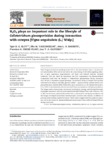Use este identificador para citar ou linkar para este item:
http://www.alice.cnptia.embrapa.br/alice/handle/doc/1021576Registro completo de metadados
| Campo DC | Valor | Idioma |
|---|---|---|
| dc.contributor.author | ELOY, Y. R. G. | pt_BR |
| dc.contributor.author | VASCONCELOS, I. M. | pt_BR |
| dc.contributor.author | BARRETO, A. L. H. | pt_BR |
| dc.contributor.author | FREIRE FILHO, F. R. | pt_BR |
| dc.contributor.author | OLIVEIRA, J. T. A. | pt_BR |
| dc.date.accessioned | 2015-08-07T11:11:11Z | pt_BR |
| dc.date.available | 2015-08-07T11:11:11Z | pt_BR |
| dc.date.created | 2015-08-07 | pt_BR |
| dc.date.issued | 2015 | pt_BR |
| dc.identifier.citation | Fungal Biology, v. 119, p. 747-757, 2015. | pt_BR |
| dc.identifier.uri | http://www.alice.cnptia.embrapa.br/alice/handle/doc/1021576 | pt_BR |
| dc.description | Plant-fungus interactions usually generate H2O2 in the infected plant tissue. H2O2 has a direct antimicrobial effect and is involved in the cross-linking of cell walls, signaling, induction of gene expression, hypersensitive cell death and induced systemic acquired resistance. This has raised the hypothesis that H2O2 manipulation by pharmacological compounds could alter the lifestyle of Colletotrichum gloeosporioides during interaction with the BR-3-Tracuateua cowpea genotype... | pt_BR |
| dc.language.iso | eng | eng |
| dc.rights | openAccess | eng |
| dc.subject | Peróxido de hidrogênio | pt_BR |
| dc.title | H2O2 plays an important role in the lifestyle of Colletotrichum gloeosporioides during interaction with cowpea [Vigna unguiculata (L.) Walp.]. | pt_BR |
| dc.type | Artigo de periódico | pt_BR |
| dc.date.updated | 2015-08-07T11:11:11Z | pt_BR |
| dc.subject.thesagro | Feijão de Corda | pt_BR |
| dc.subject.thesagro | Fungo | pt_BR |
| riaa.ainfo.id | 1021576 | pt_BR |
| riaa.ainfo.lastupdate | 2015-08-07 | pt_BR |
| dc.contributor.institution | YGOR R. G. ELOY, UFC/ UNIFOR; ILKA M. VASCONCELOS, UFC; ANA LUCIA HORTA BARRETO, CPAMN; FRANCISCO RODRIGUES FREIRE FILHO, CPAMN; JOSE T. A. OLIVEIRA, UFC. | pt_BR |
| Aparece nas coleções: | Artigo em periódico indexado (CPAMN)  | |
Arquivos associados a este item:
| Arquivo | Descrição | Tamanho | Formato | |
|---|---|---|---|---|
| ArtigoAnaHortaFungalBiology2015.pdf | 3,31 MB | Adobe PDF |  Visualizar/Abrir |









